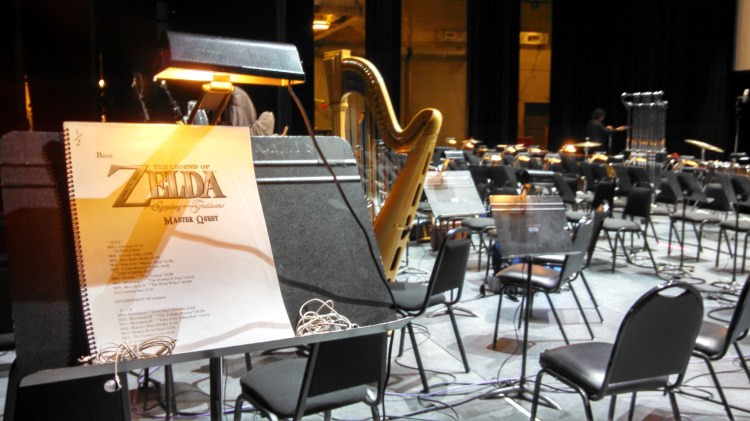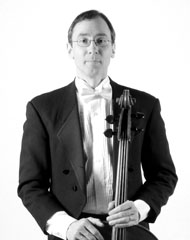So Andrew Mellanby of the Kitchener-Waterloo Symphony made the arrangements with Paul, got the scores for his musicians to practice with for The Legend of Zelda: Symphony of the Goddesses Master Quest concert, and passed them along for the players to learn on their own.
“The musicians did not see the entire score, but we were given MP3 recordings of each piece to practice with to get a sense of how it all fits together,” cellist Chris Sharpe said. “It’s not typical to get recordings provided, but musicians are resourceful at finding recordings of unfamiliar pieces to practice with.” (“YouTube is a great resource,” Mellanby said.)
Sharpe said he looked over the music without his cello at first, to get a sense of how hard it would be to play and the style. Next up was a quick practice, looking at tempo markings and the tricky bits where he’d need to spend the most time honing his performance.
“Musicians need to manage their practice time carefully, especially as we’re not only learning the music for this concert but also for a number of upcoming concerts,” Sharpe said. “As I practiced, I identified which pieces I would need to play along with the MP3 recordings — again, as a way to practice most efficiently. Difficult passages required the most time, starting with slow practice and working up to the performance speed.”
2 months before the show: The tour begins
Not many of Paul’s staffers travel with the actual production: Each show is typically coordinated by an organizer for the local symphony. The composer, Andersson, is one of just a few people who see every performance.
Over the course of this year, she’ll lead more than 70 productions of the symphony, spending just a few days in each city in a tour that spans more than a dozen countries.
“Our hotel on site is booked through JMP Productions. The touring team all stay there together,” Andersson said. “Steven Lemke, our technical director, and I often pair up and eat dinner or breakfast together. We talk about the technical aspects of the show, especially the orchestral rehearsals.”
A naturally active person, she finds it a challenge when flights are delayed or a long layover intrudes and she’s stuck spending a good chunk of her life in airports.
“I don’t really get to see much locally, except a good restaurant when we have a night free. It is pretty much steady hard work, and a vigorous schedule. The schedule is especially tough when shows are booked back-to-back.”
2 days before the show: The first, and only, rehearsal
The Wednesday before the performance, the orchestra and choir gathered for the first time for one three-hour rehearsal.
It may sound strange that the symphony doesn’t get more time to practice together, but these are pros, Mellanby said. It’s a little-known fact that symphony performers are often able to sight-read their music with no preparation whatsoever.
“I focus most of my energy on getting tempo transitions right, coordinating them with the (video) and then achieving musical expression,” Andersson said.
The rehearsal is mostly the time for the conductor to pass along her final thoughts on phrasing and emphasis and to make sure that transitions with the choir, which acted as almost a vocal instrument for this performance, were handled well. Other than one 20 minute sound check, it’ll be the only time everyone plays together on the symphony before the performance.
“The main objective of the rehearsal is to get clear direction from the conductor to fit our individual parts together as accurately and as musically as possible,” Sharpe said. “The conductor uses this short time to give key instructions on style and balance as well as keeping the orchestra together rhythmically.”
It’s not enough just to play one part well, Mellanby said. In addition to working with the rest of the orchestra, each musician also has to fit into the structure of the stage setup itself.
“Rehearsal time is also used to make sure all of the technical elements are working well in conjunction with what the orchestra is doing,” he said. “Lighting, projection, video playback, mics, audio playback, and even more practical physical things like chairs, music stands, stand lights, and the player’s own instruments all have to in working order and work together to make the concert a success.
“It takes a lot of planning and work ahead of the first rehearsal to make sure all those elements are going to be where they need to be, doing what they need to do, at the time they need to do it. Rehearsal is really the testing stage to make sure all the pieces fit together so that the audience gets a great experience.”
The afternoon before the show: Final setup
It might have been the day of the Zelda show, but the symphony was thinking about Star Wars. Before the Zelda performance, they were deep into another rehearsal, this one for their presentation of the Star Wars soundtrack, played live along with the film in a performance they would tackle the very next day.
In fact, Zelda was just one of five shows the group would put on in five days.
But as soon as the strains of “The Imperial March” had faded, Mellanby was on the move, getting instruments and music stands and tablets and earbuds in place onstage for the performance that night.






